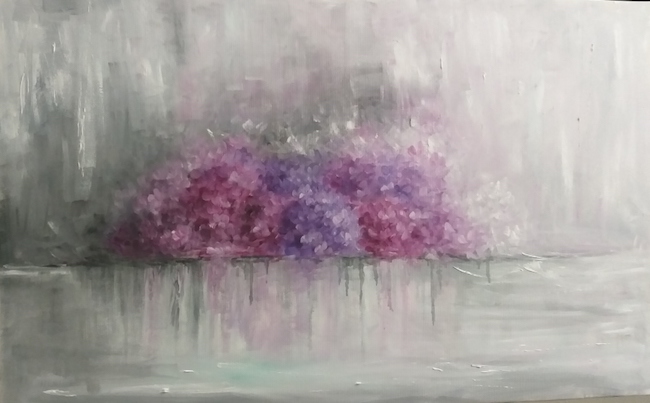L’approccio alla tela è talmente soggettivo e individuale da rendere quasi impossibile definirne i confini, soprattutto quando gli artisti tendono a personalizzare gli stili pittorici affinché si armonizzino alla perfezione con il loro intento creativo, con la modalità espressiva più affine al sentire interiore. L’artista di cui vi racconterò oggi riesce a coniugare due correnti apparentemente opposte eppure in grado, grazie al filtro della sua emotività, di dare vita a un linguaggio unico ed emozionante.
Nel momento in cui l’arte di fine Diciannovesimo secolo ha cominciato a mostrare l’esigenza di distaccarsi dalle regole precedenti per dar vita a un inedito modo di intendere la rappresentazione pittorica non solo dal punto di vista dei soggetti raffigurati bensì anche nell’uso dei colori e della loro stesura, tutto il mondo artistico ha subìto una forte scossa da cui si sono successivamente originate ulteriori trasformazioni e modernizzazioni di cu quell’inizio fu la base da cui svilupparsi. Il primo movimento a decretare l’inizio dell’allontanamento dagli schemi più classici fu l’Impressionismo poiché gli artisti aderenti compirono una vera e propria rivoluzione in virtù della loro tendenza a dipingere en plein air, volendo cogliere la luce e gli istanti esattamente come apparivano davanti ai propri occhi in maniera istintiva e immediata, e, di conseguenza, non potevano partire dal disegno, che avrebbe richiesto un approccio più studiato, bensì agendo direttamente attraverso pennellate di colore brevi e veloci necessarie a catturare la luce e il movimento e a narrare l’istante così come colto nel momento in cui l’esecutore dell’opera li aveva davanti. Qualche anno dopo la nascita dell’Impressionismo si affermò in Francia una linea di pensiero completamente contrastante, quella dei Fauves, in cui ciò che era necessario lasciar emergere era la pura sensazione, senza che fosse indispensabile la riproduzione della realtà cosi come osservata anzi, ciò che doveva predominare era l’impetuosità e la forza del sentire interiore che si ripercuoteva sulla realtà circostante; fu proprio da quell’idea che nacque e si consolidò agli inizi del Novecento, l’Espressionismo, un vero e proprio movimento a cui aderirono tutti gli artisti per i quali l’estetica e la riproduzione di tutto ciò che ruotava loro intorno erano irrilevanti rispetto ai moti dell’animo, ai disagi interiori o al semplice desiderio di dissacrare le rigide norme e l’ipocrisia che si respirava nei salotti borghesi dell’epoca. Dunque la bellezza e la magia delle tele di Claude Monet e Pierre-Auguste Renoir erano in contrasto con l’irruenza e il tormento delle tele di Edvard Munch e di Emil Nolde o le grottesche scene di James Ensor. L’artista triestina Michela Grassi genera nelle sue opere una congiunzione tra i due stili apparentemente opposti eppure in realtà perfettamente accordabili in virtù della necessità dell’artista di inserire e manifestare le proprie emozioni in quella soffice narrazione di tutto ciò che il suo sguardo ha colto e che poi la memoria riproduce sulla tela; è quasi una pittura del ricordo e della sensazione quella che contraddistingue la Grassi, laddove l’atmosfera silenziosa ed emozionante viene introdotta dalla sua capacità di porsi in posizione di ascolto rispetto a quanto viene dall’interno ma anche dall’esterno.
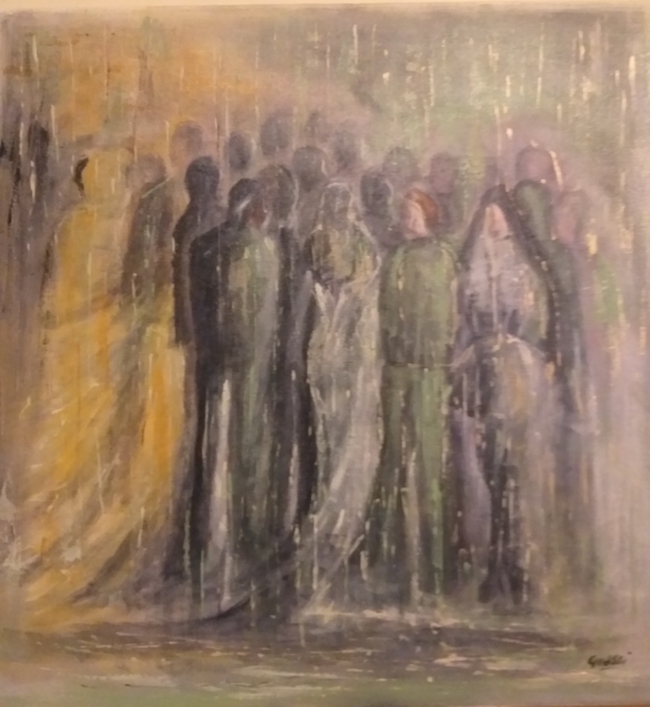
Tutto ciò che il suo sguardo incontra raggiunge la sua interiorità e fuoriesce poi con la medesima intensità che lei stessa ha avvertito e che non può fare a meno di comunicare, avvolgendo così le opere della sensibilità con la quale osserva l’ambiente circostante. Le brevi pennellate, la straordinaria capacità di catturare la luce e la predilezione di frammenti di vita all’aperto o dettagli della natura la avvicinano allo stile impressionista, tanto quanto l’alterazione della gamma cromatica, l’assenza della prospettiva, del racconto del visibilmente reale e la mancanza dei dettagli delle persone protagoniste delle tele la avvicinano all’Espressionismo.
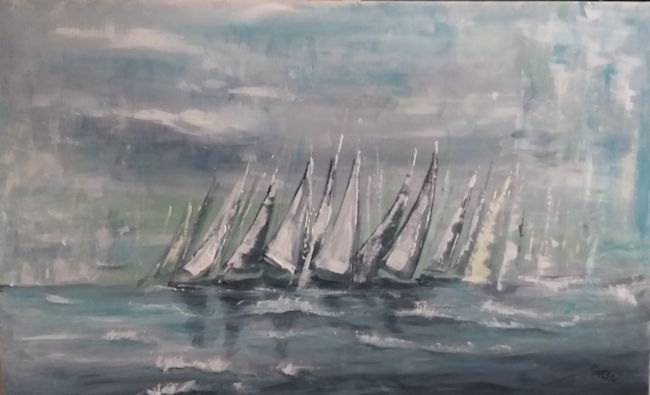
Riproduce scene di regate, ciò che fin da bambina ha visto nella sua città, Trieste, luogo di mare, e dunque nelle sue opere è impossibile non percepire il fascino che le barche a vela esercitano su Michela Grassi, quasi come se le ricordasse con lo stesso sguardo di bambina con cui le ha osservate la prima volta.
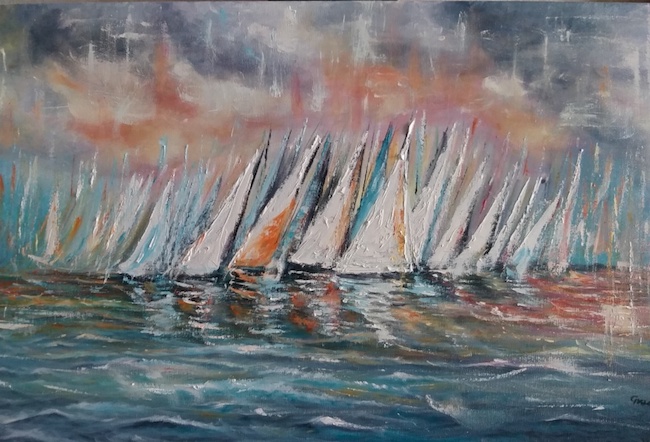
L’opera Tramonto sulla regata lascia emergere l’attenzione al dettaglio dell’artista che però al tempo stesso si perde nell’insieme corale delle vele, del rumore del mare, del brusio della folla che osserva, invisibile ma immaginabile in virtù della scena narrata; il dettaglio è semplicemente funzionale al punto di vista più ampio, come se ciò che deve fuoriuscire sia la pura emozione nel trovarsi davanti a quello spettacolo di barche, solo apparentemente cullare dal mare mentre in realtà cercano di domarne e sfidarne la forza. La natura e le sue meraviglie sembrano essere gli elementi principali dell’espressione pittorica di Michela Grassi che si lascia ammaliare dalla bellezza eterea e soffice delle ortensie, simbolo di amore, di serenità e protagoniste di molte tele nelle quali l’artista ne racconta infinite declinazioni, attraverso le molteplici sfumature e l’armonia che il delicato fiore riesce a emanare nell’ambiente circostante, indipendentemente che quest’ultimo sia più o meno favorevole.
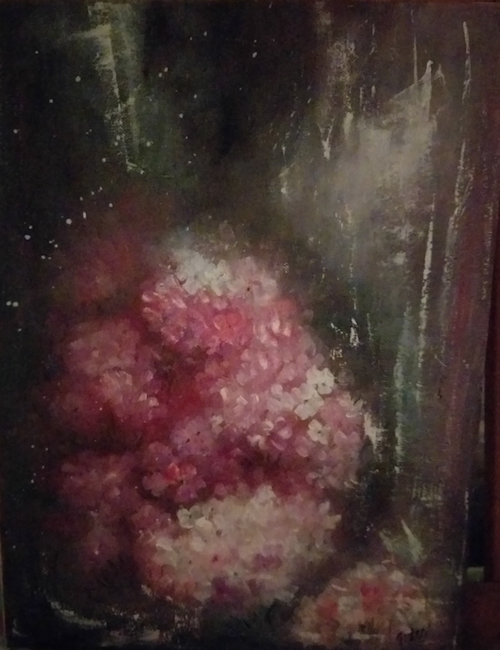
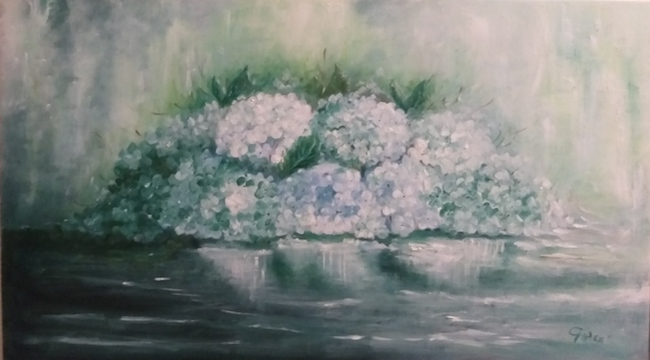
Ecco dunque che immergendole in un paesaggio freddo ne fa risaltare il calore che fuoriesce dai colori, in uno mattutino ne evidenzia la freschezza e l’impalpabile delicatezza; è proprio nelle nature morte che la pittura della Grassi volge quasi al Metafisico più per la sua tendenza a sospendere il tempo e lo spazio che non per le caratteristiche di mistero e di inspiegabile che alla corrente appartengono. In ogni caso il risultato è emozionante, musicale nel suo silenzio e un delicato invito a lasciarsi andare e perdersi nelle pieghe della semplicità, delle piccole cose naturali che rendono l’esistenza più piacevole.
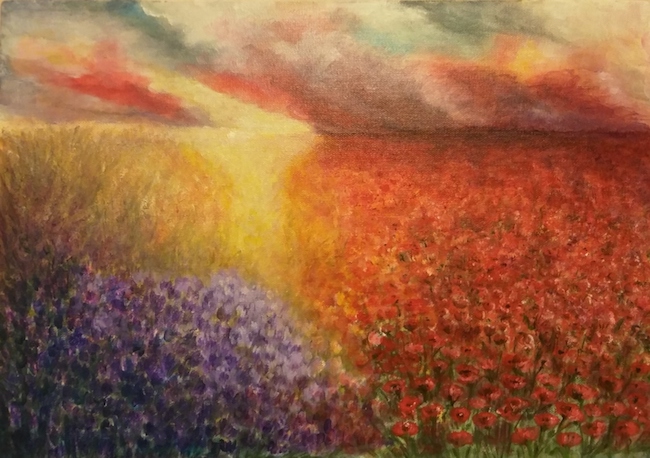
E questo concetto, che forse sarebbe meglio definire invito, esplode prorompente nell’opera Tempesta di colori in cui l’approccio espressionista è funzionale a lasciar emergere il senso di pace ma anche di gioia provato dall’artista nel momento in cui il suo sguardo ha vagato su quelle colline piene di fiori immaginandone tonalità fiabesche esattamente in virtù della sensazione sognante che ha avvertito e che l’ha poi indotta a raccontare su tela quel paesaggio. Nelle opere in cui rende protagoniste le persone però Michela Grassi perde completamente il legame con la realtà osservata per entrare nel campo della pura emozione, in quel sentire e compartecipare che diviene l’essenza stessa della narrazione, come se non possa esservi descrizione senza che entrino in campo le sensazioni che dominano tutta la sua produzione artistica.
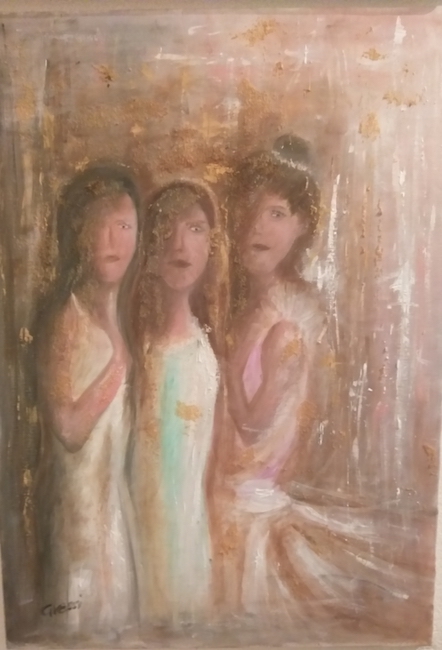
In Il sogno rubato la focalizzazione verte su un tema delicato, quello di un passato lontano eppure incredibilmente recente durante il quale le donne ambiziose, audaci, esuberanti, erano considerate scomode e pericolose per le regole della società e perciò rinchiuse negli istituti di igiene mentale. Sembrano quasi dover diventare invisibili le ragazze raccontate da Michela Grassi, eppure la loro personalità riesce comunque a emergere attraverso gli sguardi fieri, la posizione eretta e sicura, quasi come se il tentativo di renderle silenziose non riuscisse a cancellare la loro vera essenza. Michela Grassi scopre fin da giovane la passione per l’arte che, nonostante lo stile ancora acerbo, le permette di esporre le sue opere in diverse mostre nella zona di Trieste e nelle città di confine tra Italia, Austria e Slovenia. Poi però deve accantonare l’arte a causa di scelte professionali e di vita fino a quando l’amore per la pittura non ritorna prepotentemente a farsi sentire e da quel momento di due anni prende parte a numerose mostre collettive a Trieste e a Venezia.
MICHELA GRASSI-CONTATTI
Email: michelagrassi1971@libero.it
Facebook: https://www.facebook.com/michela.grassi.94
The soft and nuanced world of Michela Grassi’s artworks, between Impressionism and Expressionism
The approach to the canvas is so subjective and individual that it is almost impossible to define its boundaries, especially when artists tend to personalise painting styles so that they harmonise perfectly with their creative intent, with the mode of expression most akin to their inner feelings. The artist I am going to tell you about today succeeds in combining two currents apparently opposing yet able, thanks to the filter of her emotionality, to create a unique and exciting language.
When art at the end of the 19th century began to show the need to break away from the previous rules and create a new way of understanding pictorial representation, not only from the point of view of the subjects depicted but also in the use of colours and their drafting, the entire artistic world underwent a strong shake-up from which further transformations and modernisations originated. The first movement to decree the beginning of the departure from the more classical schemes was Impressionism, since the artists who adhered to it accomplished a real revolution by virtue of their tendency to paint en plein air, wanting to capture light and moments exactly as they appeared before their eyes in an instinctive and immediate manner, and, consequently, they could not start from the drawing, which would have required a more studied approach, but acted directly through short, quick strokes of colour needed to capture the light and movement and to narrate the moment as it was caught in front of them.
A few years after the birth of Impressionism, a completely contrasting line of thought took hold in France, that of the Fauves, in which it was necessary to allow pure sensation to emerge, without it being essential to reproduce reality as it was observed; on the contrary, what should predominate was the impetuousness and strength of the inner feeling that had an impact on the surrounding reality; it was precisely from this idea that Expressionism was born and consolidated at the beginning of the 20th century, a real movement to which adhered all those artists for whom aesthetics and the reproduction of everything that revolved around them were irrelevant compared to the motions of the soul, inner discomfort or the simple desire to desecrate the rigid rules and hypocrisy that one breathed in the bourgeois salons of the time.
Thus the beauty and magic of Claude Monet’s and Pierre-Auguste Renoir’s paintings contrasted with the impetuousness and torment of Edvard Munch’s and Emil Nolde’s canvases or James Ensor’s grotesque scenes. The artist from Trieste, Michela Grassi, generates in her artworks a conjunction between the two styles, apparently opposite and yet in reality perfectly in tune with each other by virtue of the artist’s need to insert and manifest her own emotions in that soft narration of everything that her gaze has caught and that her memory then reproduces on the canvas; it is almost a painting of memory and sensation that distinguishes Grassi, where the silent and emotional atmosphere is introduced by her ability to place herself in a position of listening to what comes from within but also from outside. Everything that her gaze encounters reaches her interiority and then emerges with the same intensity that she herself has felt and that she cannot help but communicate, thus enveloping the artworks with the sensitivity with which she observes the surrounding environment. The short brushstrokes, the extraordinary ability to capture light and the preference for fragments of outdoor life or details of nature bring her closer to the Impressionist style, just as the alteration of the colour range, the absence of perspective, of the narrative of the visibly real and the lack of details of the people in the canvases bring her closer to Expressionism.
She reproduces scenes of regattas, what she has seen since she was a child in her city, Trieste, a seaside place, and therefore in her artworks it is impossible not to perceive the fascination that sailing boats exert on Michela Grassi, almost as if she remembered them with the same childlike gaze with which she first observed them. The work Sunset on the regatta reveals the artist’s attention to detail, but at the same time she loses herself in the choral ensemble of sails, the sound of the sea, the buzz of the crowd watching, invisible but imaginable by virtue of the scene narrated; the detail is simply functional to the broader point of view, as if what must emerge is the pure emotion of being in front of that spectacle of boats, only apparently cradled by the sea while in reality they are trying to tame and challenge its force. Nature and its wonders seem to be the main elements of Michela Grassi’s pictorial expression. She lets herself be enchanted by the ethereal and soft beauty of hydrangeas, symbol of love, serenity and protagonists of many paintings, of which the artist tells about infinite declinations, through the multiple nuances and the harmony that the delicate flower is able to emanate in the surrounding environment, regardless of whether the latter is more or less favourable. So, by immersing them in a cold landscape she brings out the warmth that comes out from the colours, in a morning landscape she highlights the freshness and the impalpable delicacy; it is just in the still lifes that Grassi’s painting turns almost to the Metaphysical, more for her tendency to suspend time and space than for the mysterious and inexplicable characteristics that belong to the current. In any case, the result is exciting, musical in its silence and a delicate invitation to let go and lose oneself in the folds of simplicity, of the small natural things that make existence more pleasant.
And this concept, which perhaps it would be better to define as an invitation, bursts forth in Tempesta di colori (Storm of Colours), in which the Expressionist approach serves to bring out the sense of peace but also of joy felt by the artist at the moment when her gaze wandered over those hills full of flowers, imagining fairy-tale hues precisely because of the dreamy sensation she felt and which then led her to recount that landscape on canvas. In the artworks in which she makes people the protagonists, however, Michela Grassi completely loses the link with the observed reality to enter the field of pure emotion, in that feeling and sharing that becomes the very essence of the narration, as if there can be no description without the feelings that dominate all her artistic production coming into play. In The stolen dream the focus is on a delicate theme, that of a distant yet incredibly recent past during which ambitious, audacious, exuberant women were considered inconvenient and dangerous by the rules of society and therefore locked up in mental institutions. The girls told by Michela Grassi seem almost to have to become invisible, yet their personality still manages to emerge through their proud looks, their erect and confident posture, almost as if the attempt to make them silent did not succeed in erasing their true essence. Michela Grassi discovered her passion for art at an early age and, despite her still immature style, she was able to exhibit her paintings in various exhibitions in the Trieste area and in the border towns of Italy, Austria and Slovenia. But then she had to put art on the back burner due to professional and life choices until her love for painting came back and, from two years ago, she took part in numerous group exhibitions in Trieste and Venice.
MICHELA GRASSI-CONTACTS
Email: michelagrassi1971@libero.it
Facebook: https://www.facebook.com/michela.grassi.94


